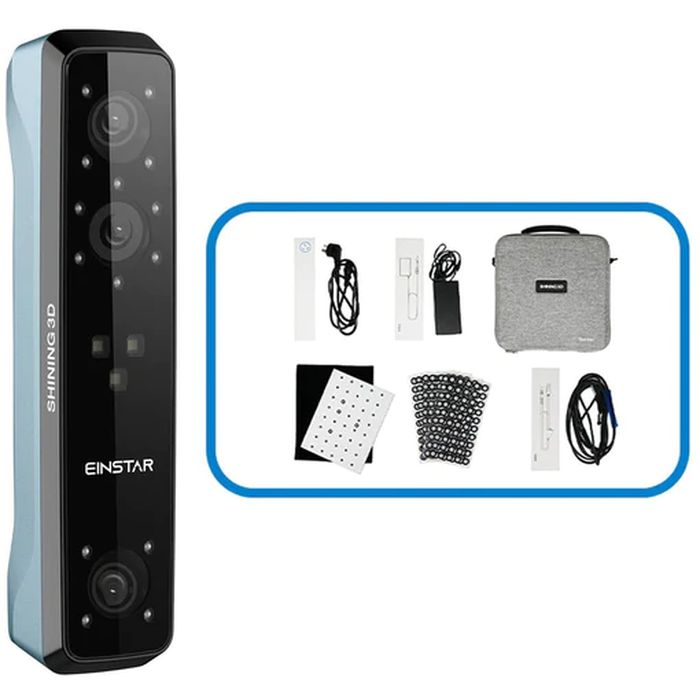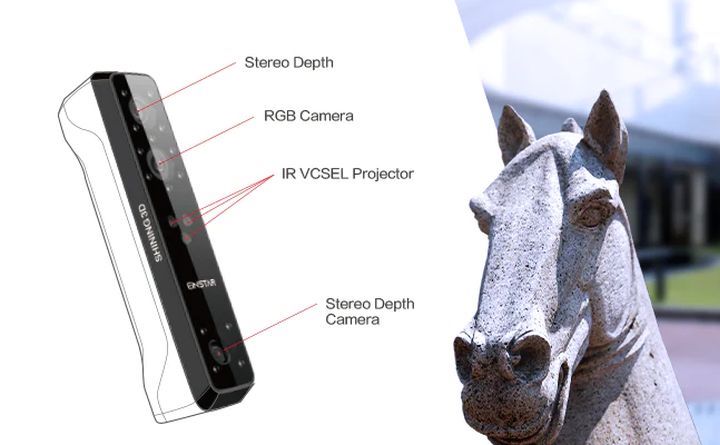
Shining 3D announced a new and very affordable handheld 3D scanner, the Einstar.
Shining 3D has been producing highly functional 3D scanners of various styles for several years, and most recently we checked out their unusual dual range 3D scanner.
Recently they announced another product, the Einstar handheld 3D scanner and it could be a price breakthrough.
When I first encountered handheld 3D scanners a decade ago, the pricing was through the roof. It was not uncommon for a device to cost as much as US$60,000. Nowadays the pricing is quite a bit lower due to technological advances and certainly competition. Good quality handheld 3D scanners now go for between US$3,000 to US$20,000 or so.
This is where the Einstar differs: it’s priced at only US$959 (and was on sale at launch for US$799!)
But is the Einstar good enough to be used as a handheld 3D scanner? Let’s take a look at its characteristics.
First, it’s a device that must be paired with a powerful laptop, which is where most of the computation takes place. In a way, the Einstar is basically a specialized camera that runs from software on a PC. Don’t think badly of this approach, though, as it’s successfully used by several scanner manufacturers in a way to reduce pricing and increase computational power.
However, the result of this approach is that the scanning operator is tethered to a PC during scan operations. This can be a bit tricky as you must manage the cable while moving around the subject, and sometimes that requires an assistant.

The Einstar is shipped in a lightweight carrying case with accessories including positioning markers, cleaning cloths, strap, power supply and cables. This makes the Einstar quite portable and should enable more flexible use.

The Einstar is equipped with two stereo depths cameras, three infrared projectors and an RGB camera to capture color textures. This makes it possible to be used outdoors, where bright sunlight can sometimes mess with other scanners.
The biggest problem with handheld scanners is the ability to track subjects. Sometimes tracking is “lost”, and you have to restart your scan. However, Shining 3D explains that the Minster’s software has “smart tracking performance”, “automatic alignment” and “intelligent algorithm”. That sounds good, but I’d like to test this device in action to see how well it tracks, and how easy or hard it might be to lose tracking.
One clue is that the Einstar can manage up to 14fps, which I believe is somewhat slow for scanning. That’s not surprising, given the price point of this device. The implication, however, is that you likely will have to move somewhat slowly during scanning.
The scanning range is pretty decent at 160-1400mm — this is the range within which the subject must be placed, although Shining 3D recommends 400mm as the optimal distance. In fact, the software shows a “red yellow green” visual display to assist the scanning operator during the job.
One good feature is the weight of the Einstar: only 500g. This is important because the operator must hold the device for longer periods, twisting it around in a smooth manner, etc. Some handheld scanners are quite heavy and can be tiresome to use.
Shining 3D recommends a laptop with at least 32GB RAM, and a graphics card with at least 6GB VRAM. As you might have suspected, the software is Windows only.
If you’re looking for an inexpensive handheld 3D scanner, the Einstar might be for you.
Via Einstar
